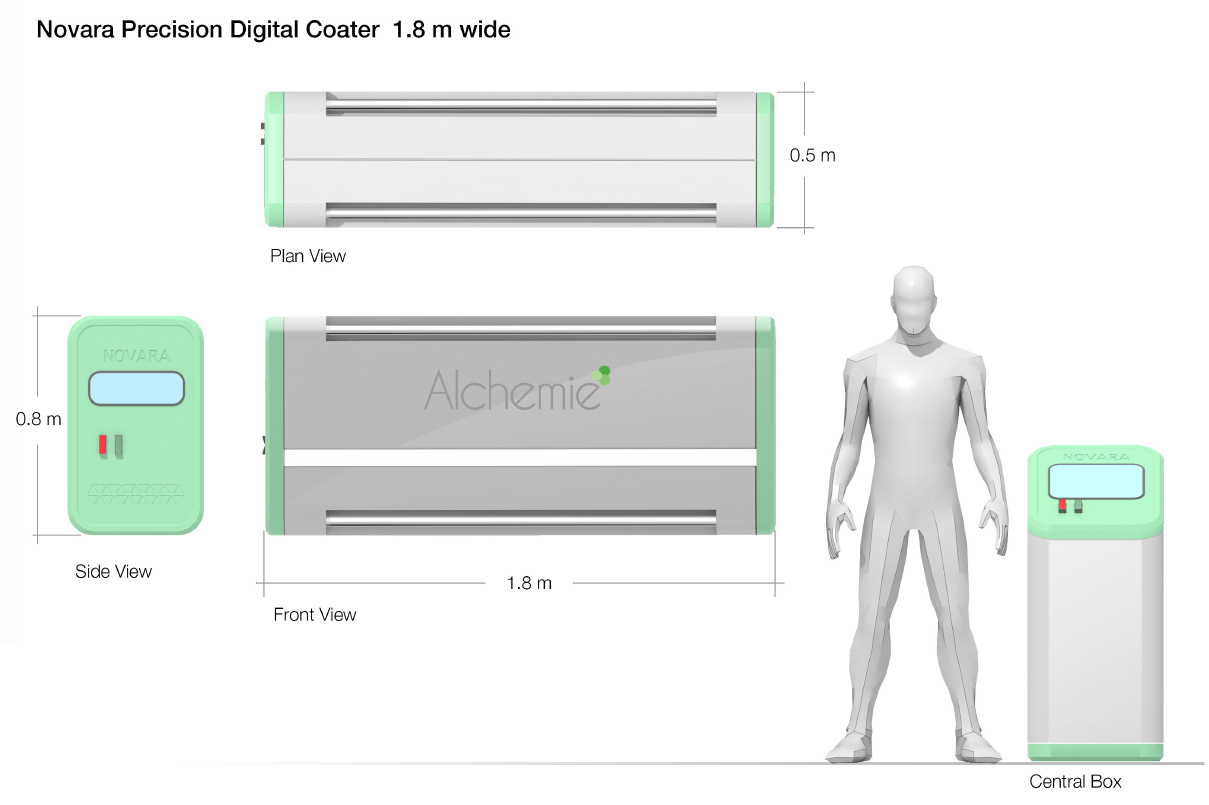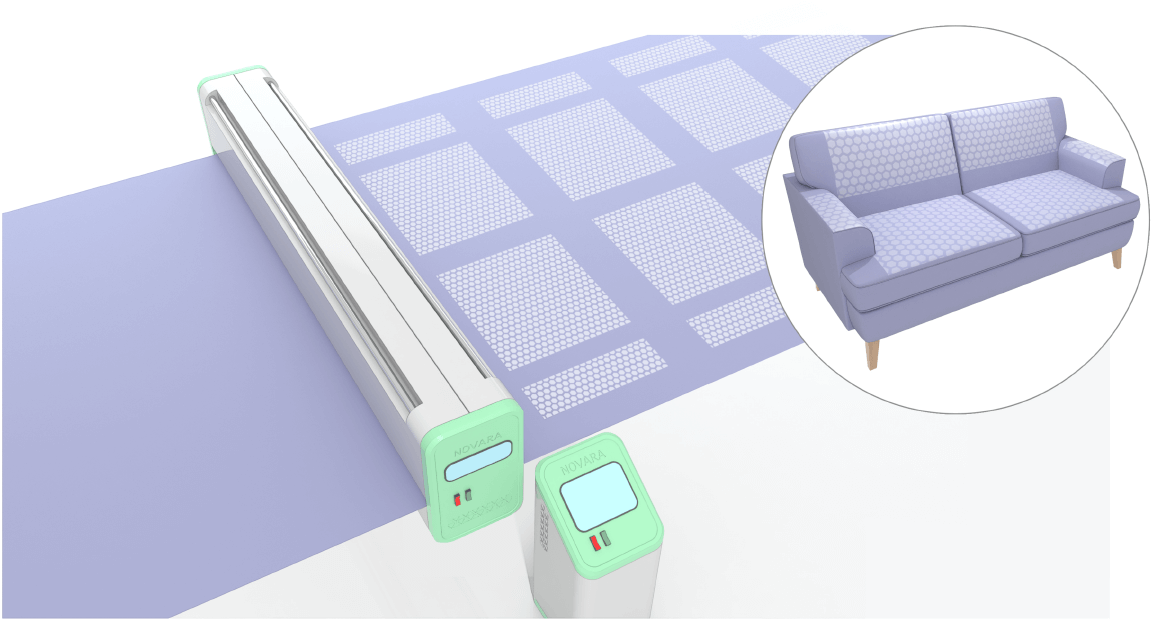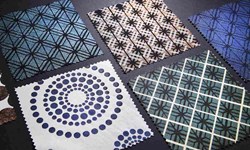Alchemie’s Dr Simon Kew talks to Madelaine Thomas about the company’s new Novara technology and how it can help fight Covid-19.
With the ongoing Covid-19 pandemic, the desperate need for medical textiles, with anti-viral coatings has arisen, whether that is face masks, hospital linen, or protective clothing, to name but a few applications.
In light of this, UK-based technology company Alchemie Technology has accelerated the launch of its Novara technology, a “breakthrough new high-throughput digital precision coating technology for technical textiles,” according to the company. Through this early release, the textile technology innovator is supporting the global efforts to combat Covid-19 by applying its Novara technology to the manufacture of safety-critical products including anti-viral face masks. Alchemie is actively partnering with manufacturers worldwide to build production lines to address acute personal protective equipment needs and medical textile shortages.
“We have accelerated the launch of our Novara textile coating technology to address the critical shortages of personal protective equipment worldwide,” says Dr Simon Kew, managing director at Alchemie Technology. “Our team has been working hard to ready Novara, our breakthrough technology for coating technical textiles, to support the frontline efforts to combat Covid-19. We predict that the worldwide requirement for face masks will be over 50 million per day and we are getting ready to address this urgent need.”
He adds: “We were getting a lot of enquiries from people asking if we could do coatings for face masks. And particularly, people are very interested in the idea of doing two-sided coating. They want to put an antiviral on one side and a water-resistant [coating] on the other side to try and make a single layer face mask. It inspired us to focus on getting this product ready for launch, which was only the last couple of months.”
Technology
Alchemie has been working on the Novara coating technology for two years. It is based on similar core technology from the company, which was officially launched last year – it’s Endeavour on-demand dyeing system. “We’re leveraging the Endeavour platform to create this product because both are effectively precision liquid applicators,” says Kew. “There are a few differences in coating which mean you need to do a few different things, but they are quite similar technologies.”
Both solutions are based on inkjet technology, similar to digital textile printing. With Novara, Kew says that coatings can be applied with a high level of precision, so manufacturers can basically print coatings under digital control, like digital inkjet printing. “What we’re talking about is digitally printing functional coatings/finishes on to textiles.”
One of the core parts of the technology, again like in inkjet printing, is the print head. Like Endeavour, the Novara uses Alchemie’s own proprietary print heads, specifically designed for jetting high-viscosity coatings. This is one difference between the Novara and the Endeavour as the Endeavour heads are designed for inks. Kew says: “This system is designed for high viscosities, so typically coatings can be high-viscosity fluids. Another difference is, for the Novara coating system, there’s basically two options: it could be a one-sided coating or two-sided, whereas for Endeavour it’s always a two-sided machine.”
The machine is also much faster than conventional coating methods such as padding. Kew says: “Coating speeds [of the Novara] are quite high: coating between 25 and 50m/min at 1.8m wide. Typical pad coating lines can be coating at 10m/min.”
Additionally, the Novara system can either be a standalone machine or it can be a module that can fit to a company’s current manufacturing line. “So, if you’ve got a stenter for example, you can bolt our machine [the Novara] on to it [the stenter],” explains Kew.
There are also no constraints in terms of textiles; any fabric can be coated. “It’s a non-contact applicator as well so structured substrates, that aren’t very easy to raw coat such as fleece, can be coated,” says Kew.
With an optional integrated in-line infrared drying system, no other post-treatment is needed, and depending on the chemistry, no pretreatment is required before the fabric is coated either.
Pre-launch
Previous to the accelerated launch, Alchemie had demonstrated the technology in a lab and at pilot scale. What the company hadn’t done, is define and design the machine. “We’ve now got a fully designed machine, a two-sided Novara coating machine,” comments Kew.
He continues: “What we decided to do is all the design work required to define what this machine is going to do and what it’s going to look like. We’ve now built a machine prototype which is basically a final machine, in Cambridge, UK, that we are using to do coating trials for customers.”
The machine is commercialised and available to order now with a fully defined specification package.
“We’ve got a lot of interest in doing face mask coating and other medical applications including surgical clothing, surgical drapes, curtains, bedwear – people are really interested in putting anti-viral coatings on to products such as bedwear to reduce the amount of risk to health workers,” says Kew. “What people are very worried about is health care workers contracting coronavirus, so they want everything in the environment to be coated with some sort of anti-viral chemistry.”
Advantages
Alchemie’s Novara technology delivers high-precision 2D patterned one or two-sided functional coatings to technical textiles, enabling unique multi-functional textiles to be manufactured. The system combines the throughput of conventional coating technologies with the precision of digital to unlock new product design opportunities and radically reduce the cost of technical textiles. The technology enables functional coatings to be applied with unparalleled precision; all controlled with real-time digital data, says the company.
Dr Alan Hudd, chairman at Alchemie Technology, says: “Our Novara precision coating technology is a breakthrough for digital technical textile manufacturing. Our digital manufacturing approach to textile coatings will finally bring the limitless flexibility of digital printing to functional coatings.”
Kew adds: “The whole idea is to create a high level of flexibility because it’s driven by digital data and the ability to put patterns down that aren’t defined by the [fabric] roll circumference.” In effect, manufacturers could put very big patterns down, because it doesn’t need to be done on a roll, and coat two-sided.
Also, he explains “one of the big things is that manufacturers only put the coating where they need it. The coating chemistry is quite expensive and often when coating fabric, using conventional technology like a padding system, you have to put the coating all over the fabric and on both sides and often that’s a waste of coating. This makes it much more cost effective to do [manufacture] technical textiles.”
For Kew, there are three critical benefits to Novara: “One is digital on-demand, one is sustainability - and that’s simply because we are using less coating – and the third one is new product innovation, which enables manufacturers to do different things with Novara compared to pad coating to create new products.”
On-demand production
In terms of digital on-demand, the system is again similar in concept to a digital inkjet printer whereby the user can download their coating pattern or coating material to a computer and that computer will then define what comes out of the manufacturing process.
“What it then means is that users can connect this machine up to their enterprise-level software: their resource planning software or digital manufacturing, factory of the future-type software system,” says Kew. “For example, with a manufacturer coating some material for a US clothing brand, the brand orders 1000 metres of coated material, they can literally press ‘order’ and that order can go directly through the software systems to the factory floor.”
Thus, rather than producing large amounts of stock and holding a lot of stock in an inventory, manufacturers can make-to-order and do short runs at low cost. “The advantages are really, from a manufacturing perspective, trying to get the inventory as small as possible and maybe get to the point where inventory is almost zero and consumers are ordering products and it’s being made-to-order rather than being made-to-stock,” explains Kew.
Technology such as the Novara, which has the ability to produce on-demand, also creates capacity for localised production. The technology acts as an enabler for the reshoring and/or nearshoring movement.
“Brands are very interested in the idea of bringing dyeing and finishing much closer to the customer,” says Kew. “It’s two things really: one is that it’s moving the processes out of wet chemistry factories and putting them into Tier 1 garment manufacturers – it’s shortening the supply chain.
“The second thing is around reshoring fabric dyeing, coating and finishing and bringing it into market. Particularly for high-value products, a lot of the coated products are high value. And particularly at the moment with the Covid-19 crisis, people are getting really interested in this idea that, for face masks for example in the UK, they really need to be made in the UK to be available to the NHS and to consumers. Also, it’s important for governments to be able to control the supply of these really critical products.”
The reshoring trend has been in the background of the industry, especially in the US, for years. But the Covid-19 crisis, Kew forecasts, is going to drive the reshoring movement for certain manufactured goods such as medical products. “We can move a lot of that into the countries in which they’re being used,” he says.
Sustainability
When it comes to Kew’s second point, the sustainability advantages, there are a number of angles. Firstly, Kew says, “because we can do 2D patterning, it means we can use a lot less coating to deliver a product.” With a face mask, for example, if only one part of the fabric needs coating, that can be achieved, which is not only more sustainable but more affordable as well. “One of the big needs for the future, and for now as well, is for low-cost technical textiles for medical applications,” says Kew.
“One of the reasons that face masks don’t really work at the moment is that the cheap ones don’t stop water accumulating in the mask from breath and that water is a really nice environment for a virus to sit in, so the effectiveness of face masks isn’t very good and that’s driven by cost,” he adds. “So if you could make it more cost effective to put functional coatings down then you can make these benefits more readily available to the hundreds of millions of people that are going to need them.”
With pad coating, both sides of the whole fabric need to be coated and no pattern can be put down. “Because we can pattern the coating and because we can put it on one or two sides, it means we can reduce the amount of coating we are using by a lot – the coating consumption can be half or even less [of pad dyeing] to get the same properties,” continues Kew. But this also means that a lot less energy is being used to dry or cure the coating on the textile.
Also, once a material is coated, it can no longer be recycled. “But if manufacturers are cutting out products, panels for T-shirts or whatever product it is, if they can keep the coating off the part that they’re cutting out, then it can be recycled a lot more easily,” Kew says.
He adds: “We’ve had a lot of interest in Endeavour for that; dyeing to shape. If manufacturers dye just the bit that they need, it makes the cut-out waste more recyclable.”
Product innovation
With the two-sided coating and patterning, the Novara technology allows for new product innovation, crucial in times of crisis. “It enables manufacturers to deliver multi-functional chemistries that can include anti-viral properties,” says Kew.
“As the world fights Covid-19, the textiles that we interact with can play a role in reducing the number of viral transmissions and whether that’s face masks, car seats, aeroplane seats or surgical drapes or clothing – adding an anti-viral capability is going to be something that is going to be quite a long-standing need in the world,” Kew adds.
Additionally, with the Novara process, companies can very quickly add high-capacity coating into their manufacturing operations. “If at the moment a company is not doing coating, by implementing a Novara they can very quickly become capable of producing coated textiles and a lot of the coated textiles are going into medical applications and technical applications,” says Kew. “It’s a very quick way of building capacity.”
A challenging time
It’s true that everyone in business, across industries, are facing many challenges in the current Covid-19 crisis. For Alchemie, its robust supply chain has opened up in a bid to come together and help get the technology off the ground so badly needed medical textiles can be created.
“In a strange way, we’re actually accelerating our capability to deliver because one of the main applications of the Novara product is face mask coating,” says Kew. “We have a lot of very helpful suppliers in our supply chain who are willing to do things more quickly to help support us.”
He adds: “We also have customers who are interested in doing whatever they can to help us accelerate the build of these machines.”
And although customers can’t physically come to visit the machine, the company has implemented virtual tours. Kew notes that the company has had to be “creative with [its] customer interaction”. But he continues, “in terms of our ability to deliver this technology to the market, we’re really well placed to get a few of these machines out into the world to address this really urgent need for face masks.”
Have your say. Join the conversation and follow us on LinkedIn






